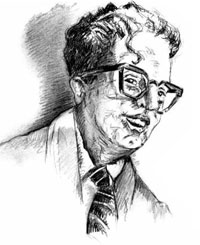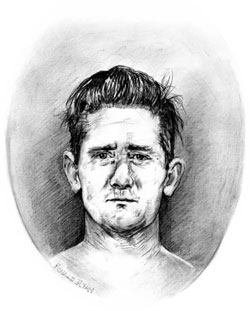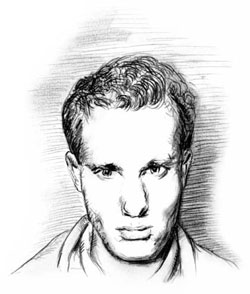Crime Time: Australians Behaving Badly (9 page)
Read Crime Time: Australians Behaving Badly Online
Authors: Sue Bursztynski
Tags: #Children's Books, #Education & Reference, #Law & Crime, #Geography & Cultures, #Explore the World, #Australia & Oceania, #Children's eBooks
MURRAY BERESFORD ROBERTS
CON ARTIST
H
e was born in New Zealand in 1919 and his name was Murray Roberts … or was it John Cook? John Jackson? How about Sir Leonard Jackson? Lord Russell?
This man used a lot of names during his life of deceit. The name he was born with though, was Murray Beresford Roberts and he spent his first 27 years in New Zealand. He began to study medicine at the University of Otago, but never bothered to finish his degree.
That didn’t stop him from practising medicine. In 1941 he worked as a locum, a doctor who covers for another doctor who is busy, sick or on holidays. He was caught out by the authorities and fined 50 pounds.
That didn’t put Murray off; next, he posed as a high-ranking army doctor.
Perhaps he decided that he’d fooled all the people he could in New Zealand. Whatever the reason, he moved to Australia after the war in 1946.
Murray managed to get several jobs by claiming to have a lot of university degrees he didn’t have. In Western Australia, in 1949, he married his first wife, a typist called Dorothy. For some reason, he used a fake name, John Malcolm Cook. The marriage lasted six years, with one son. It would be interesting to know what he told his wife about how he was earning a living.

Murray just couldn’t help himself. He liked playing doctors and teachers (he didn’t have teaching qualifications, any more than he had medical ones). He was good-looking and spoke beautifully. Everyone believed him. Even some people who had worked with him still liked him after they found out the truth.
In Melbourne, during 1954, he made money under the name of ‘Professor Sir Leonard Jackson’, saying he was a prosecutor in the Petrov royal commission, which was checking out spying in Australia. When he needed to speak to a prisoner in Goulburn jail, in New South Wales, he pretended to be a surgeon. He even offered to do a muscle graft at the Goulburn Base Hospital the next day.
Luckily for the poor patient, he never turned up!
In Tasmania, in 1956, he took 50 pounds from a truck driver as a deposit on a house. The trouble was, he didn’t actually own the house he was selling.
His next scam was in Sydney, where he posed as the new Governor-General of Australia! It worked long enough to get him a luxury hotel suite, but not long enough. After doing prison time, he was shipped back to Tasmania to stand trial for the cons he’d carried out there.
Unfortunately, Murray still couldn’t see that he’d done anything wrong – and he couldn’t resist playing more roles. In Brisbane, in 1958, he claimed to be a judge of the New Zealand Supreme Court. He left for Sydney without paying his hotel bill and was charged with theft.
Still, he hung around in Sydney, where he posed as a Baron Alfred von Krupp and promised Manly a brand new car park. The Sydney public was amused, but the court wasn’t; he got another jail sentence.
By this time, he’d been divorced from Dorothy for five years, and married again, to a woman called Beryl. Poor Beryl didn’t know her husband was called Murray Roberts. She thought he was John Jackson. Again, the court was not amused. In March, he got another prison term, for lying to the marriage registrar, and soon after, a divorce.
Later in his life, his scams became nastier. In 1962, he played the role of a doctor again – Lord Porter, doctor to the royal family – and this time, he got 400 pounds out of his victim as payment for a cancer operation. He managed to get as far as Darwin before he was caught and brought back. This time, the jail sentence was four years.
Naughty Murray hadn’t been out of jail for long when he proposed marriage to a woman called Joyce and sweet-talked 4000 pounds out of her. Luckily for Joyce, he was caught before he could get far.
After turning to drink, he died in 1974, choking on his own vomit in a New Zealand hotel room.
Was Murray Roberts a success as a con artist? In some ways, yes, for he did fool a lot of people. But then, he also kept being caught!

DID YOU KNOW…?
Double trouble…? Most identical twins have fun confusing their teachers, parents and friends. Identical twin robbers, Peter and Doug Moran (known as the After Dark Bandits) worked together to fool police and witnesses in the late 1970s. They dressed alike and gave each other alibis. It worked for two years, but in 1979, they were caught after Peter almost killed a policeman at a bank in Heathcote, Victoria. Both got long jail sentences.
RONALD RYAN
LAST PERSON TO HANG IN AUSTRALIA
R
onald Ryan was a small-time crook whose death made him a lot more famous than his life ever had. People are still arguing over whether he actually did murder a prison guard, the crime for which he was executed. Still, his death changed Australia forever.
Ronald was born in Melbourne in 1925, to a poor family. His mother couldn’t look after him properly, so he and his sisters were taken away and put into homes for neglected children. Ronald did well at the boys’ home where he was living, but he ran away when he was fourteen. For several years, he worked honestly to support his mother and sisters, but then he began to commit crimes. Several times he went to jail for robberies and forgery, but each time he came out, he fell back into crime.
In December 1964, he was in jail again at Pentridge Prison, serving fourteen years for armed robbery. For his wife, this was the last straw. She was going to divorce him. Now, Ronald made the decision that would end up costing his life and the life of a prison guard. To save his marriage, he would escape from Pentridge. He would take his wife and three children to Brazil, where they would be safe from the Australian law.
Ronald arranged his escape with another prisoner, Peter Walker. After overcoming a guard, Helmut Lange, and stealing his rifle, the two men ran for it, alarms sounding loudly. Then the tragedy happened. Another guard, George Hodson, was running just behind Peter Walker. At this point, we’re not sure exactly what happened. Ryan might have shot Hodson to protect Walker. Later, a guard said he had fired a shot from a tower, but changed his story. Anyway, whatever really happened, Hodson died.
Ryan and Walker were on the run for nearly three weeks. While they were hiding in Melbourne, Walker shot and killed someone who recognised them. Finally, they escaped to Sydney, where they were hoping to get help from a criminal called Lennie McPherson. McPherson promised to arrange their escape to Brazil, but then he turned them in to the police instead.
Back in Melbourne, Peter Walker was sentenced to twelve years for the manslaughter of the man he had shot before they went to Sydney.
Ryan was now on trial for the murder of George Hodson. There was a lot of argument over whether or not it would have been possible for him to shoot Hodson, but the jury found him guilty. Justice Starke, a judge who was against the death penalty, was forced to condemn Ryan to hang. Starke never forgave himself.
Now the fuss began. Appeals were made and rejected. There were protests and petitions. Barry Jones, who would later become a federal Minister for Science, led a committee against Ryan’s execution. Three newspapers which usually supported the government campaigned for mercy.
Even some members of the jury begged the State Premier, Henry Bolte, to use his power to stop the death sentence. Most of the jury had wanted to find Ryan not guilty, but had been persuaded to change their minds. After all, nobody had been executed in Australia since 1951. Since then, death sentences had always been changed to life imprisonment. They had really believed that this would happen now.
But Henry Bolte wanted this execution to go ahead. A few years before, he had been stopped from executing another criminal. This time, he would show who was boss! Perhaps he believed that being firm on this matter would get him more votes in the next election.
In February 1967, Ronald Ryan went to the gallows. Some of the journalists who had to watch the hanging threw up in the toilets.
Outside the prison, 3000 protesters gathered and at the exact time he was executed, many people around Australia observed a three-minute silence.
That was the end of capital punishment in Australia. It was now clear that death sentences weren’t popular any more. One by one the states changed their laws. In 1985, Australia scrapped it altogether. During that time, nobody else was actually executed.
For sure, Ronald Ryan would have preferred capital punishment to end in a better way, but still, this petty crook made a very big difference.

DID YOU KNOW…?
It’s possible to go from national hero to national villain. Millionaire businessman Alan Bond has been both. In 1978, he was named Australian of the Year. After he won the America’s Cup yacht race in 1983, he was a national hero. A TV mini-series was made about his victory. By 1997, his business empire was crumbling and he had been declared bankrupt. He had taken a large sum of money from a company called Bell Resources, which he controlled, to prop up his own company, the Bond Corporation. Many people lost their money because of this. It got him a seven-year jail term, but he served only four, and his family paid back only a tiny amount of the $1.8 billion he owed. In 2008, Bond was back on the ‘Rich 200 List’, almost as rich as he was before.
DEREK ERNEST PERCY
CHILD KILLER
D
erek Percy has been in jail since July 1969, Victoria’s longest-serving prisoner. When he went to prison, the Apollo 11 astronauts had just walked on the moon. Television in Australia was black and white. You could buy four lollies for a cent. Computers filled whole rooms and had about the power of your pocket calculator. There was no Internet.
He was in jail for the torture and murder of twelve-year-old Yvonne Tuohy on 20 July 1969. Police suspect that he committed several other child murders, because he was near all those places at the time.
The trouble is, he can’t be DNA tested because, strictly speaking, he hasn’t been convicted. He was found not guilty due to insanity and put in jail ‘at the Governor’s pleasure’. That meant that every now and then his case would be reviewed and if it was felt that he was no longer a danger, he might be released.
So far, he hasn’t been.
Derek Percy’s family moved around a lot during his childhood. He had to keep changing schools. Because of that, he never had much chance to make friends and didn’t really try.
His diary was his only friend. One day his parents happened to look at it and were horrified by what they read. He had fantasies about torturing and killing children. The local doctor told them it was just a stage he was going through. Nothing was done.
Derek joined the navy when he was nineteen and did well. He was even considered for officer training. But he was still keeping that diary.
On Sunday, 20 July, Yvonne Tuohy, who lived in the Victorian coastal town of Warneet, suggested to her friend Shane Stiller that they go for a walk on the beach. They had sandwiches and Shane took along a small axe to chop wood for a billy tea.

On the beach, they stopped for a moment, deciding in which direction to go. Shane saw a man watching them from a car nearby. They had walked in different directions and were turning back when the man grabbed Yvonne. He demanded that Shane come to him as well, but Shane held up his axe, defending himself. He turned and ran for help. Unfortunately, the picnicking family Shane found thought he was just playing. By then, it was too late. Percy had driven off with Yvonne.
He did help police by describing the man and the car. He described a sticker on the car, which was a navy insignia.
Yvonne’s body was soon found, tied and gagged.
The homicide squad went to the Cerberus Navy Base nearby. They found Percy washing the blood from his clothes. They found the diary in his locker. Shane identified his car in the car park. Later, he identified Percy at a line-up. They had enough evidence to arrest him.
After the trial, at which Shane spoke as a witness, he never really recovered. In those days, nobody had thought of counselling. Poor Shane was told to get over it and get on with his life. He never did. He drank and suffered from depression. In 2005, he disappeared.
While Percy had certainly committed this murder, the question was what to do with him. In those days, the death sentence was still a part of law, but no one had been executed in Australia since Ronald Ryan in 1967. If he were given a life sentence, he would be out in twenty years, free to commit more murders.
Nobody sane, it was decided, could possibly have done what Percy had done. Declaring him insane and making his sentence ‘at the Governor’s pleasure’ was the only way to keep him behind bars indefinitely.
In jail, he collected stamps and played carpet bowls. When personal computers arrived, he bought one and learned how to program it. He got a pension from the navy and saved $30,000.
And he kept materials in his cell that told police he hadn’t felt at all sorry for what he had done. Psychiatrists checked him over the years. They offered him the chance to join groups for therapy. He wasn’t interested.
In the end, they concluded that Derek Percy had no mental condition they could treat. He wasn’t insane – just evil.
His case was reviewed in 1998, along with a number of other killers who were being held at the Governor’s pleasure. He was the only one still considered too dangerous to release.
In 2005, police interviewed him about a number of other murders committed in the 1960s, but he simply said he didn’t remember. They couldn’t take his DNA to check, because they only have the right to do that for convicted prisoners and he isn’t convicted. If he had been convicted, he would have to be released at some stage. The murders may remain mysteries forever.
And Percy will probably die in jail.

DID YOU KNOW…?
In 2005, two Australians who’d robbed a bank in the US state of Colorado were caught the very next day. Anthony Prince and Luke Carroll grinned at the cameras, waving their stolen money around. They wore masks for the robbery, but didn’t bother to take off the badges they usually wore in the nearby ski shop where they worked. Their Australian accents also gave them away. Instead of a getaway car, they used their work passes to catch a handy ski lift. Australian newspapers called them ‘Dumb and Dumber’.